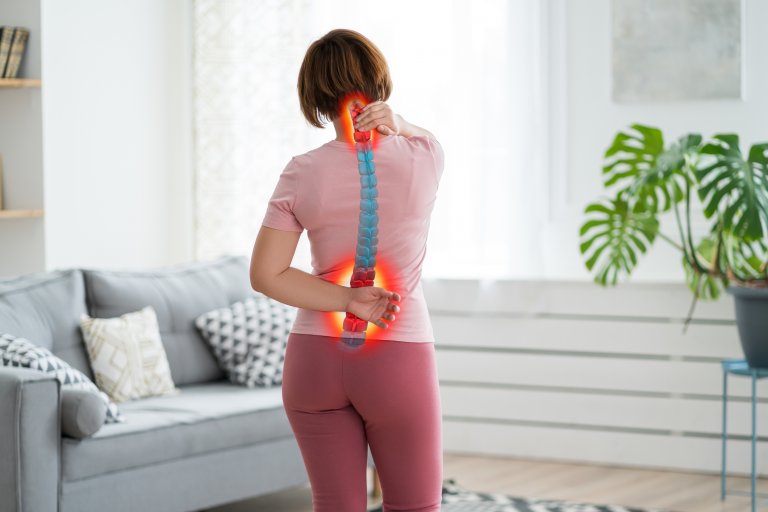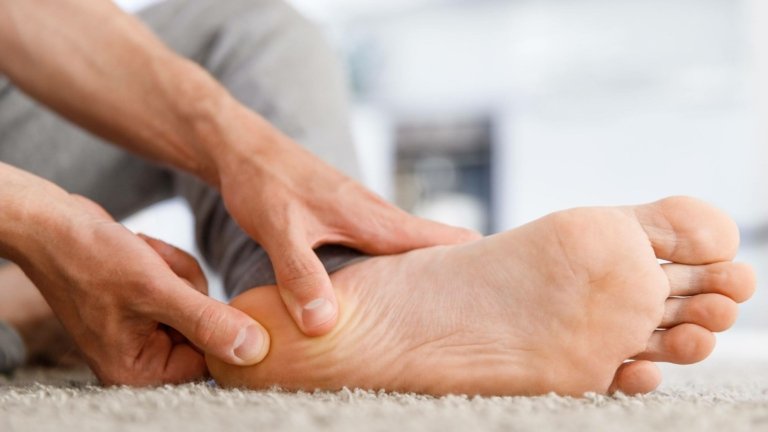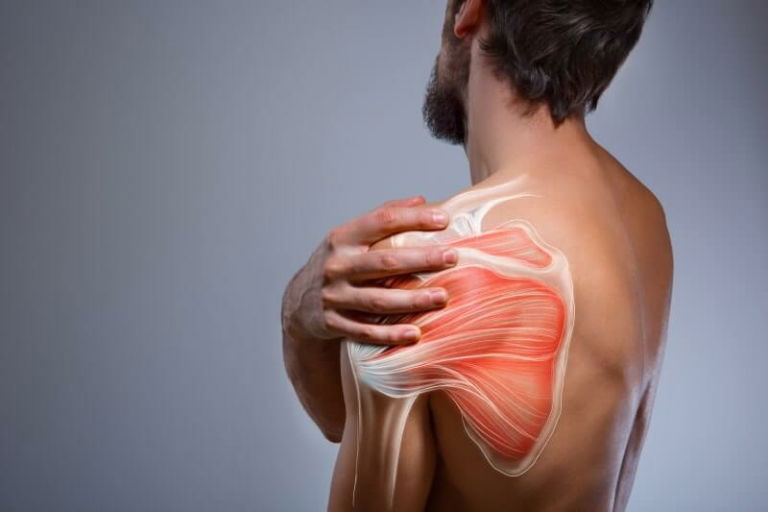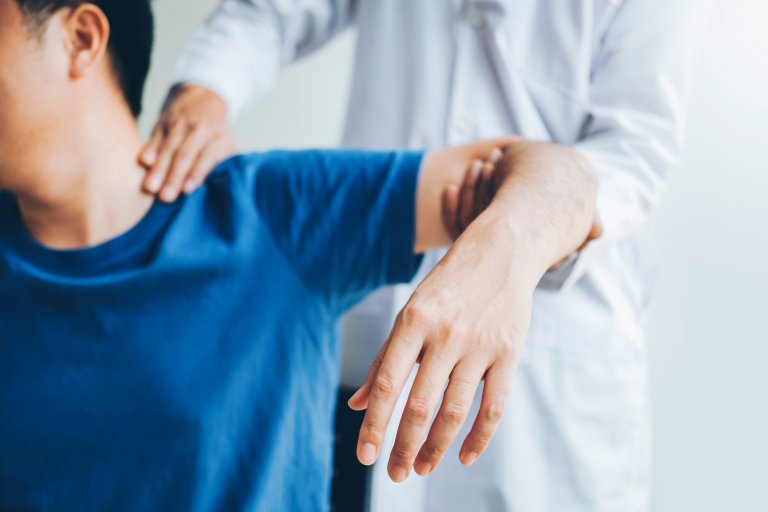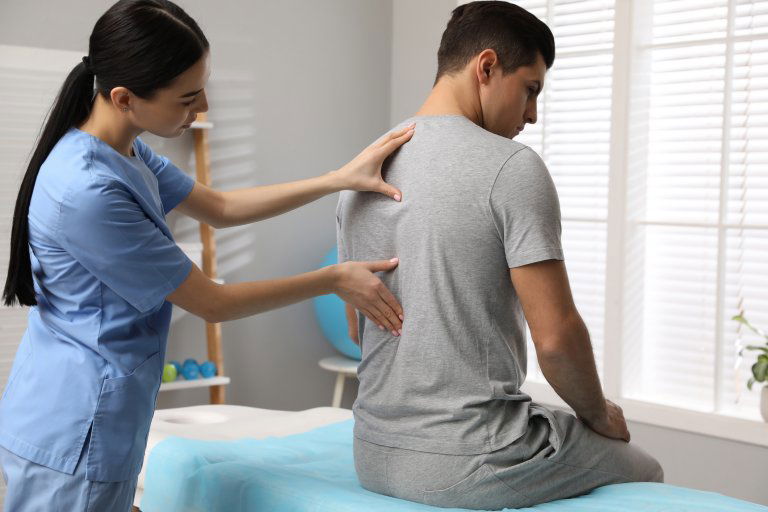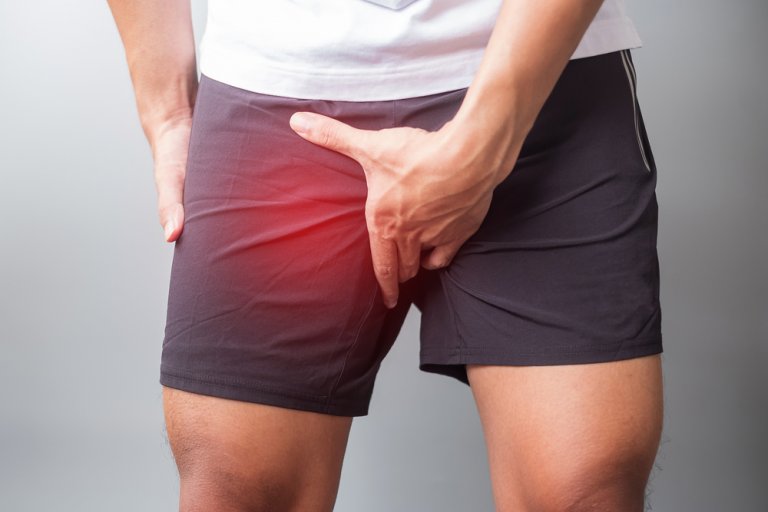Are you experiencing pain in your cervical spine? Do you have difficulty turning your head and looking left, right, up or down? Does neck pain limit your ability to perform everyday activities?
The cervical spine is an important anatomical part of the body, which carries the weight of the entire head and enables uninterrupted performance of vital human functions (breathing, swallowing, blood supply to the brain, etc.).
Conditions such as cervical herniated disc, cervical radiculopathy, cervical spondylosis, cervical spinal stenosis, and cervical vertebral fracture often occur in the cervical spine.
Ignoring neck pain can lead to many complications, such as chronic migraines, limited mobility, and permanent muscle and nerve damage.
Injuries and pain in the cervical spine often occur due to repetitive strain (working at a computer, gardening), inadequate load-bearing capacity of the cervical spine (insufficient capacity to bear loads), insufficient strength and endurance of the neck muscles, an inadequate pillow, being overweight or due to genetic predisposition.
Symptoms that occur in the cervical spine are most often neck pain, reduced range of motion, reduced muscle strength, and sensitivity to touch. Swelling and inflammation also occur often.
At MEDICOFIT clinic, we are specialists in the comprehensive treatment of cervical spine injuries and pain, guiding you from diagnostic therapy and acute physiotherapy to post-acute kinesiology and a preventive programme.
Book an appointment for neck pain treatment
To better understand the occurrence of injuries and pain in the cervical spine, it is crucial to understand the anatomical structure of the neck.
The cervical spine consists of seven cervical vertebrae (C1–C7), which are placed one above the other and are the main mechanical support for the head. They also provide flexibility to the neck due to their structure and the intervertebral discs.
Between every cervical vertebra is an intervertebral disc (except between the first and second vertebrae), which consists of a soft nucleus and a fibrous ring to facilitate the transfer of loads exerted on the cervical spine.
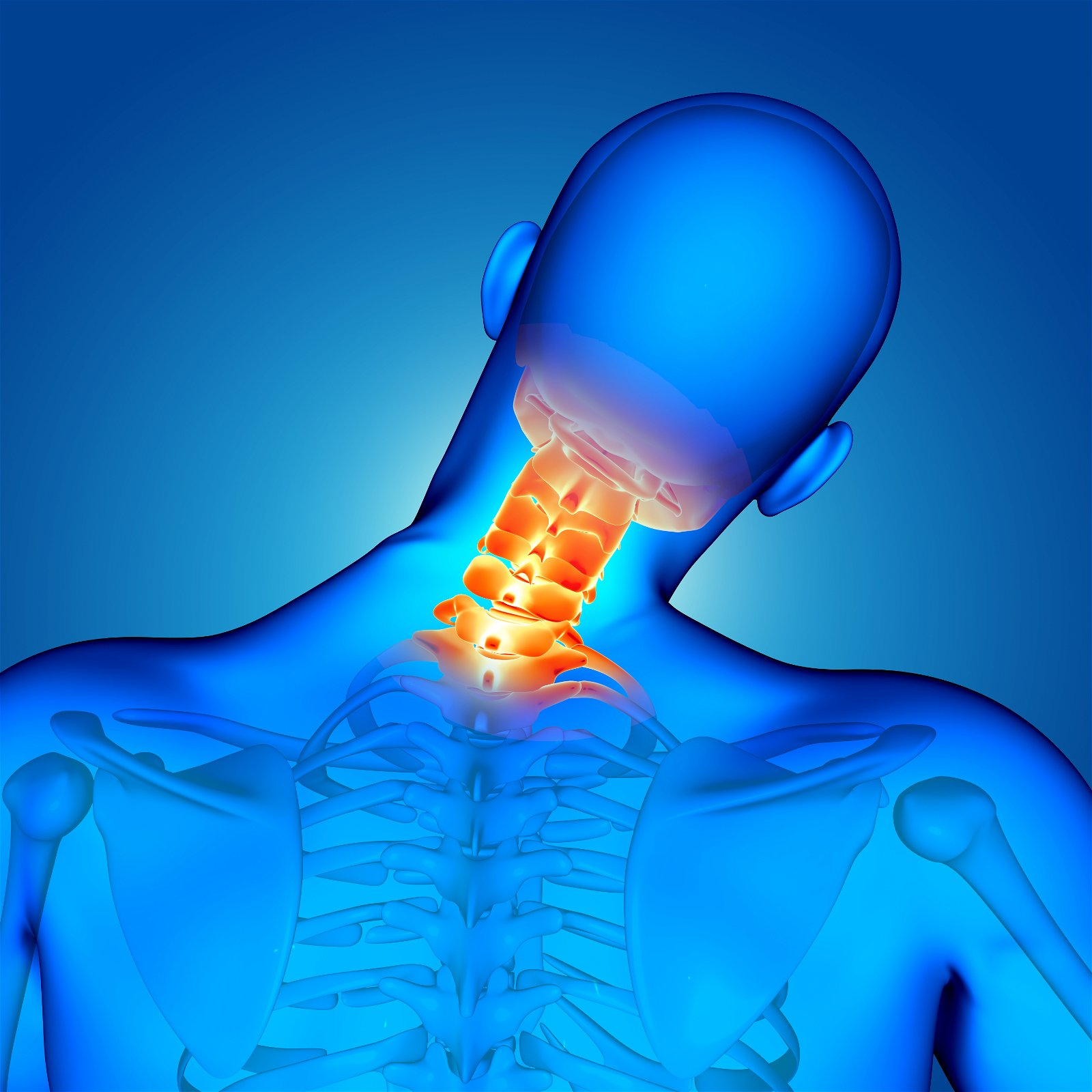
The cervical vertebrae are connected to each other by ligaments, which provide static stability and stop the movement performed by the muscles.
Running through the cervical vertebrae is the spinal cord (part of the central nervous system), from which the nerves that innervate the neck, shoulders, and upper extremities emerge.
At MEDICOFIT clinic, we are specialists in the treatment of injuries and pain in the cervical spine, often treating cervical disc herniation, cervical radiculopathy, cervical spondylosis, cervical spinal stenosis, and cervical vertebral fractures.
WHEN TO OPT FOR MEDICOFIT DIAGNOSTIC THERAPY?
- When pain persist for several days, it is necessary to undergo diagnostic therapy to prevent permanent damage.
- Neck pain is accompanied by neurological symptoms and limited mobility.
- If you have had similar problems before and the symptoms persist, it indicates that the condition has not been properly treated.
At MEDICOFIT clinic, we provide patients with scientifically supported specialist physiotherapy, which begins with booking a diagnostic therapy appointment.
Book an appointment for neck pain treatment
Cervical herniated disc
A cervical herniated disc is a condition that affects the intervertebral disc, which is located between two cervical vertebrae. The intervertebral disc bulges or tears, which compresses (causes pressure) on the nerves exiting the spinal cord.
Typical symptoms include neck pain that radiates down to the fingers, a tingling sensation and numbness throughout the upper extremity, decreased muscle strength, a feeling of stiffness in the neck, and limited range of motion. Some patients also have headaches.
A cervical herniated disc occurs due to:
- degenerative changes that occur with age,
- traumatic or sports injuries to the neck area,
- repetitive strain (e.g. office work),
- reduced load-bearing capacity of the cervical spine,
- inadequate strength and endurance of neck muscles,
- genetic predisposition.
A medical specialist makes a diagnosis based on a diagnostic examination, which includes an assessment of mobility, muscle strength, and the presence of reflexes and sensitivity in the upper extremity. Diagnostic imaging, such as X-rays or magnetic resonance imaging, is performed.
Modern physiotherapy treatment of cervical herniated disc includes manual therapy, instrumental therapy, and specialised physiotherapy training.
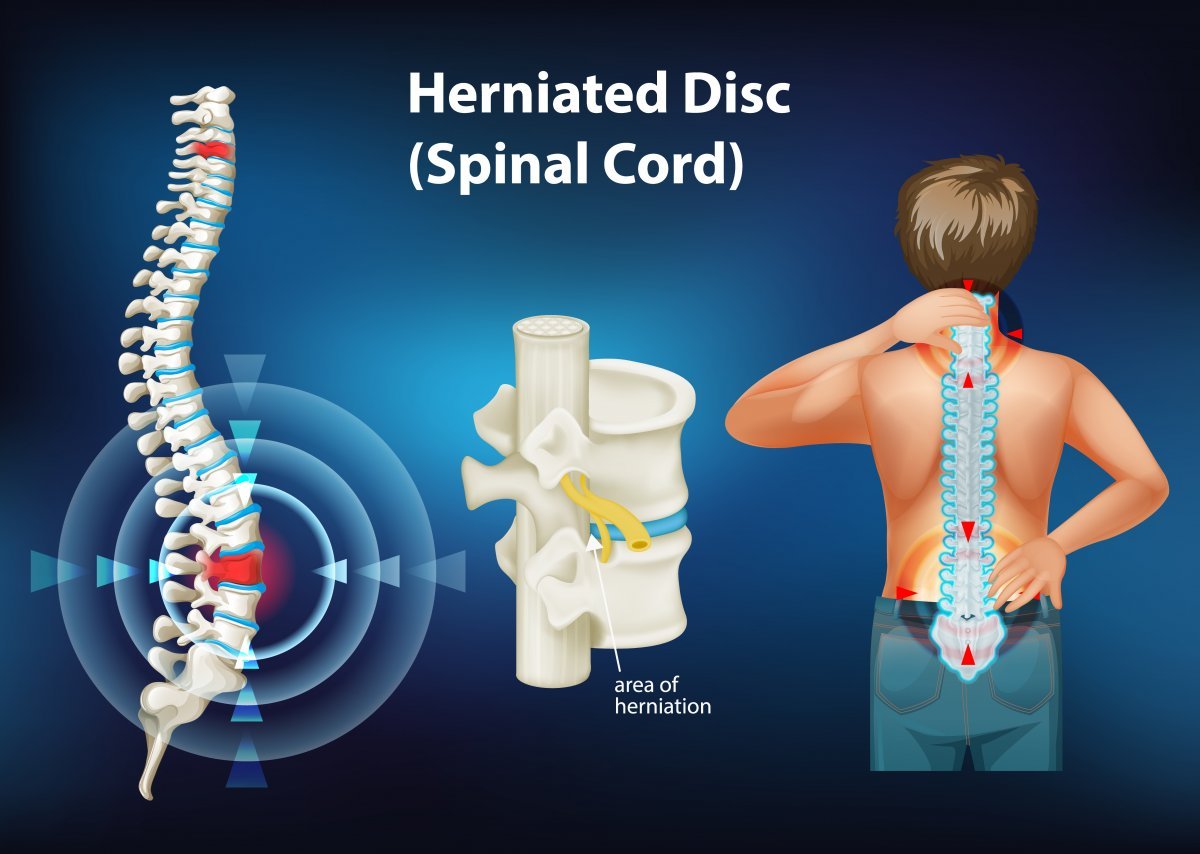
Cervical radiculopathy
Cervical radiculopathy describes a medical condition that affects the nerves in the neck due to compression or irritation, causing neurological symptoms of the disease.
Neurological symptoms include burning pain in the neck, shoulders, and fingers, tingling and numbness in the upper extremity, decreased muscle strength, impaired fine motor skills (e.g. difficulty buttoning a shirt), and loss of sensation and reflexes in the upper extremity.
Cervical radiculopathy occurs due to:
- cervical herniated disc,
- bone outgrowths that form on the cervical vertebra and press on a nerve,
- degenerative changes due to age or
- traumatic injury.
The diagnosis is made by a medical specialist using diagnostic imaging, such as X-rays and magnetic resonance imaging. Electromyography (EMG) measures nerve conduction and further confirms dysfunction of the affected nerve root.
Modern physiotherapy treatment focuses on controlling symptoms in the acute phase of treatment, which means reducing neck pain, calming inflammation, and increasing muscle strength and range of motion.

Cervical spondylosis
Cervical spondylosis is a medical condition that affects the cervical vertebrae and articular cartilage due to degenerative changes. The disease often manifests as cervical myelopathy, cervical radiculopathy, or axial neck pain.
Risk factors that influence the development of the disease are:
- traumatic spinal injury,
- anatomically reduced vertebral canal,
- dystonic cerebral palsy that affects the neck muscles,
- specific sports loads (football, horse riding).
Cervical spondylosis most often develops at the C6–C7 level of the cervical spine and at the C5–C6 level of the cervical spine.
Typical symptoms that present in patients with cervical spondylosis are:
- Axial neck pain, which is the most common symptom of cervical spondylosis and is accompanied by a feeling of tightness in the neck. The pain often radiates to the back of the neck and scapular muscles.
- Cervical radiculopathy, which develops depending on the degree of nerve root compression and manifests as radiating neck pain, arm pain, pain next to the scapula, tingling sensation, and muscle weakness.
- Cervical myelopathy, with presenting neck pain, muscle weakness in the arm, unsteady gait, loss of balance, and falls.
- Atypical symptoms arise, such as jaw pain and chest pain. Trigger points also appear in the trapezius muscle, in the cervical spinal muscles, and in the scapular muscles.
When treating cervical spondylosis, physiotherapy experts focus on strengthening spinal neck muscles, performing exercises to increase mobility, and administering pain relief therapy.
Book an appointment for neck pain treatment
Comprehensive treatment and rehabilitation at MEDICOFIT clinic begin with diagnostic therapy, acute physiotherapy and continues with post-acute kinesiology and post-kinesiology.
We perform active physiotherapy, where each patient is actively involved in their treatment process (as opposed to passive physiotherapy, where physiotherapy is performed without the patient’s involvement).
Each patient has a 60-minute individualised treatment with a physiotherapy expert (in the acute physiotherapy phase) and then with a kinesiology expert (in the post-acute kinesiology phase), as well as a 30-minute instrumental therapy.
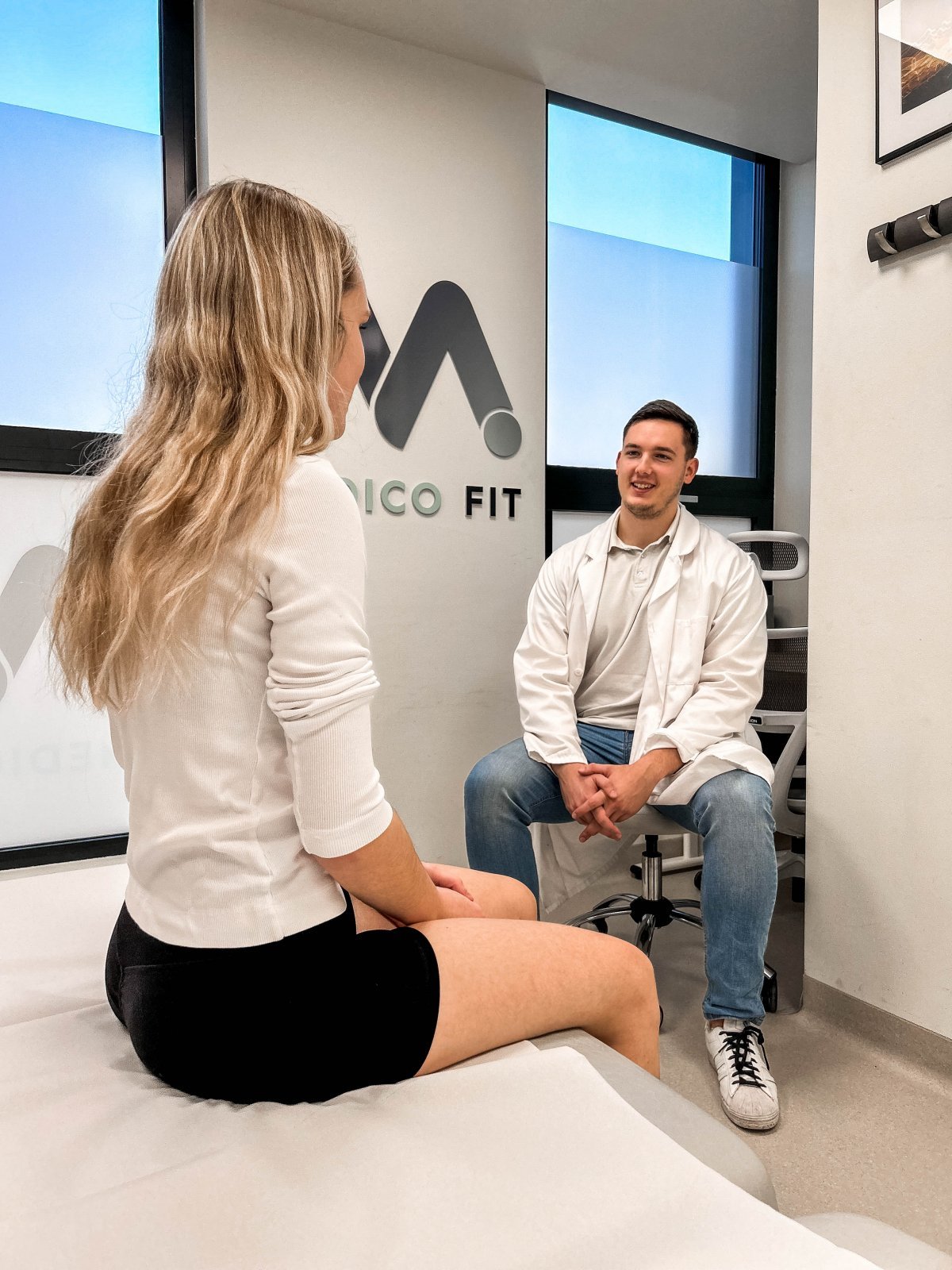
Diagnostic therapy
Diagnostic therapy is the introduction to physiotherapy treatment, in which the physiotherapist diagnostician gains insight into the functional state of your body.
It begins with an initial interview (anamnesis), which covers:
- the duration of the problem (when did the pain first appear and how has it progressed to date),
- the symptoms you noticed (if it is radiating pain, it is crucial to know where it radiates, as this makes it easier to discover the cause),
- the factors that worsen symptoms (when does the pain worsen, with which movements, with which activities),
- the cause of the pain (whether the cause of the pain was a one-time event, such as a fall or injury),
- subjective assessment of pain and
- presence of other diseases.
- Nadaljuje se z inspekcijo vratu (barva kože, vidna atrofija mišic, vidna oteklina) in palpacijo (občutljivost na dotik, temperatura in potnost kože).
This is followed by inspection of the neck (skin colour, visible muscle atrophy, visible swelling) and palpation (tenderness, temperature and skin perspiration).
Passive neck mobility measurements (where the diagnostician does the movement) and active neck mobility measurements (where you do the movement yourself) are performed. Patients with cervical spondylosis have limited range of motion in rotation (turning the head) and extension (looking up at the ceiling).
Measurements of muscle strength, endurance, and intermuscular coordination (whether muscles work in synergy) are performed. Tests are performed to assess sensitivity and reflexes, which help determine the level of potential nerve root compression or cervical myelopathy.
The load-bearing capacity of the neck is assessed (the ability of the cervical spine to bear loads – whether it is too low, sufficient or too high).
Specific tests are performed, such as the heel-to-toe test (assessing coordination and balance) and the Romberg’s test (assessing proprioception and balance).
If necessary, specialised diagnostic imaging – such as X-rays, ultrasound, or magnetic resonance imaging – is performed.
Did you know that only a medical specialist can give you a medical diagnosis?
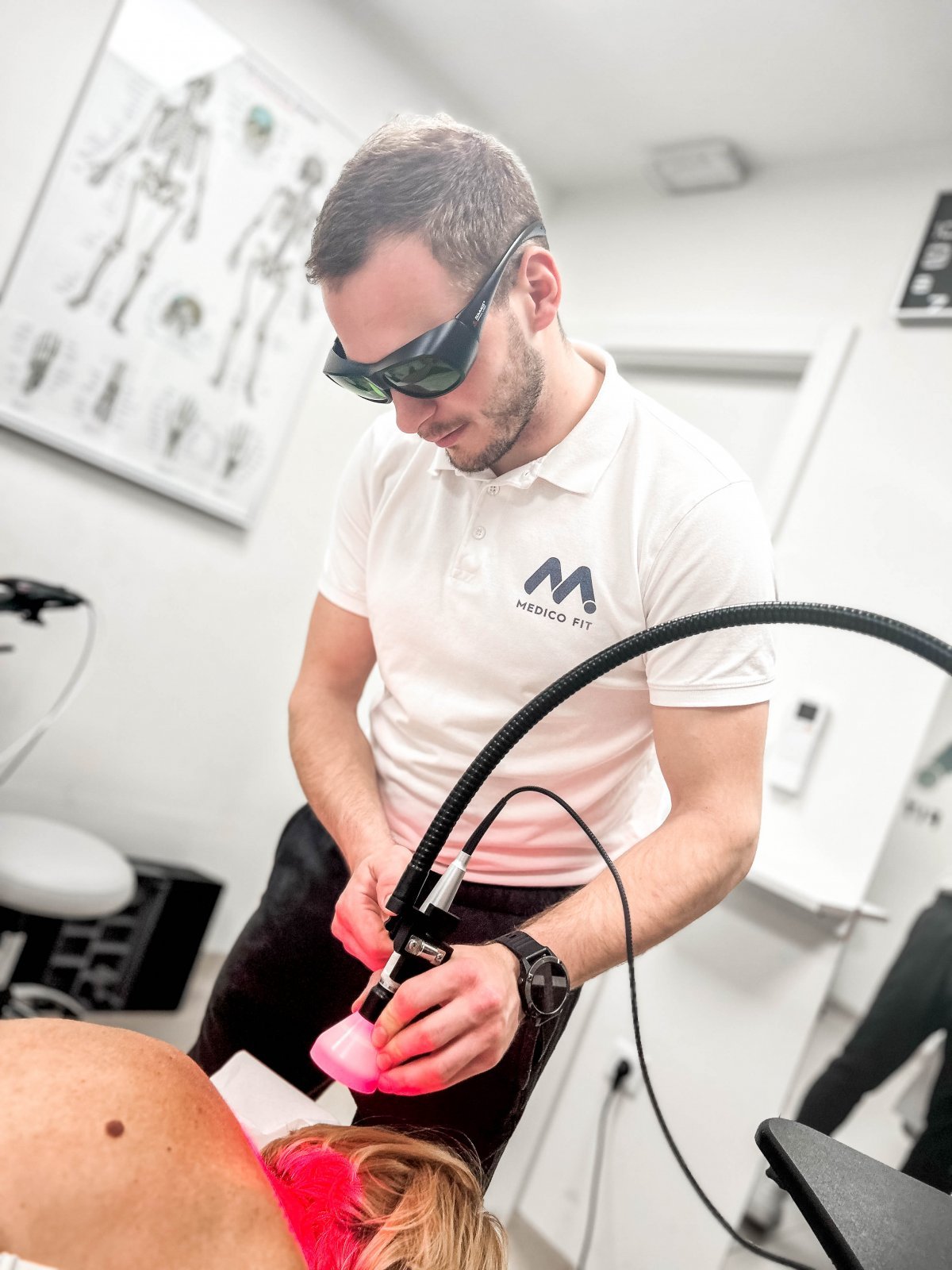
Acute physiotherapy
In the primary phase of cervical spine treatment, physiotherapy experts focus on symptom control, which means reducing neck pain, reducing swelling and inflammation, increasing range of motion, and increasing muscle strength.
Manual therapy, trigger point therapy, and joint mobilisation are performed to release overly tense neck muscles, increase neck mobility, and reduce pain.
Manual therapy is performed in combination with instrumental physiotherapy, which uses state-of-the-art devices to accelerate cellular metabolism, accelerate healing processes in the body, and reduce pain. We use:
- Wintecare TECAR therapy
- SUMMUS high-energy laser therapy
- PERISO diamagnetic therapy
- Extracorporeal shockwaves
- HiTop high-tone electrostimulation
Specialised physiotherapy training focus on establishing adequate load-bearing capacity of the cervical spine. The primary phase includes activation of the deep stabilisers of the cervical spine muscles and isometric training.
Training is continued in all directions of movement until pain occurs (flexion, extension, antiextension, lateral flexion, antilateral flexion, rotation and antirotation).
The purpose of special physiotherapy exercises is to strengthen the neck muscles, increase neck mobility and proprioception. In the event of neurological symptoms, neuromuscular training is performed to stimulate the sliding and function of the nervous system.
DANGERS AND PITFALLS OF DELAYED REHABILITATION

MEDICOFIT specialists
- Untreated neck pain can cause chronic cervical radiculopathy, where compression of the nerve roots leads to permanent neurological damage and loss of function.
- Delayed rehabilitation accelerates degenerative changes in the cervical vertebrae, which can lead to disc herniation and cervical spondylosis.
- Without specialised rehabilitation, patients develop compensatory strategies that place strain on other parts of the spine and body, leading to secondary injuries.
Inadequate or delayed rehabilitation seriously jeopardises an individual’s long-term physical health and is the main culprit for unsuccessful results and permanent movement limitations.
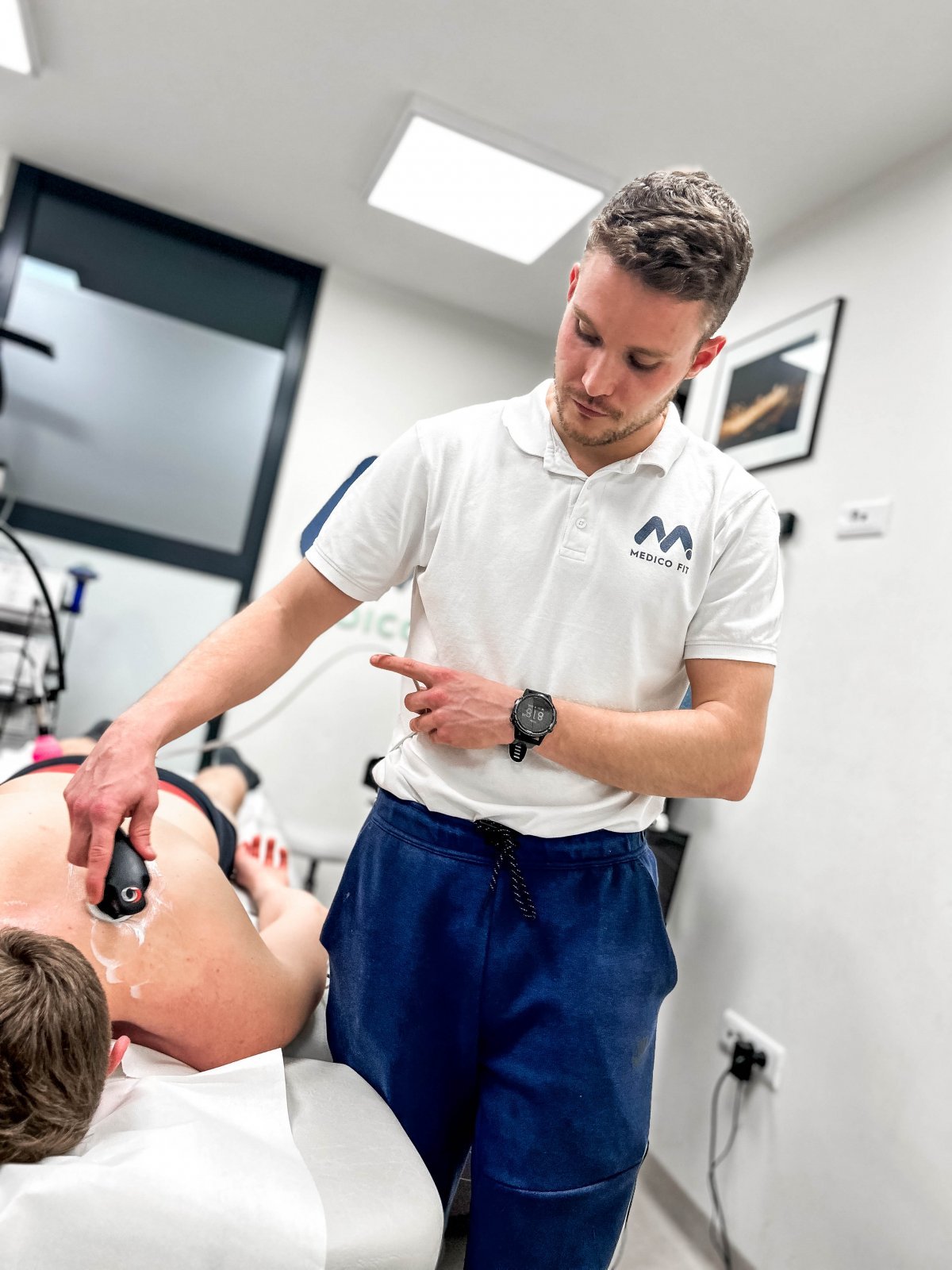
Post-acute kinesiology
After successful acute physiotherapy treatment, you will be referred to kinesiology experts, who will guide you to excellent physical fitness.
A specialised kinesiology programme includes strengthening the deep stabiliser muscles of the cervical spine and strengthening the scapular musculature.
Additionally, specialised kinesiology training is performed to strengthen the muscles of the upper extremity and the upper back.
The main goal of specialised kinesiology training is to achieve complete symmetry and muscle strength norms of the stabilising musculature of the cervical spine, improve its proprioception (spatial perception), and improve its mobility.
Progressive kinesiology training is performed, which is gradually adapted according to your progress and involves gradual return to basic exercises to strengthen your upper extremities and entire body.
Before the end of treatment, a TEST BATTERY APPLICATION is performed for the cervical spine, where we gain insight into your movement efficiency and ability to withstand daily loads.
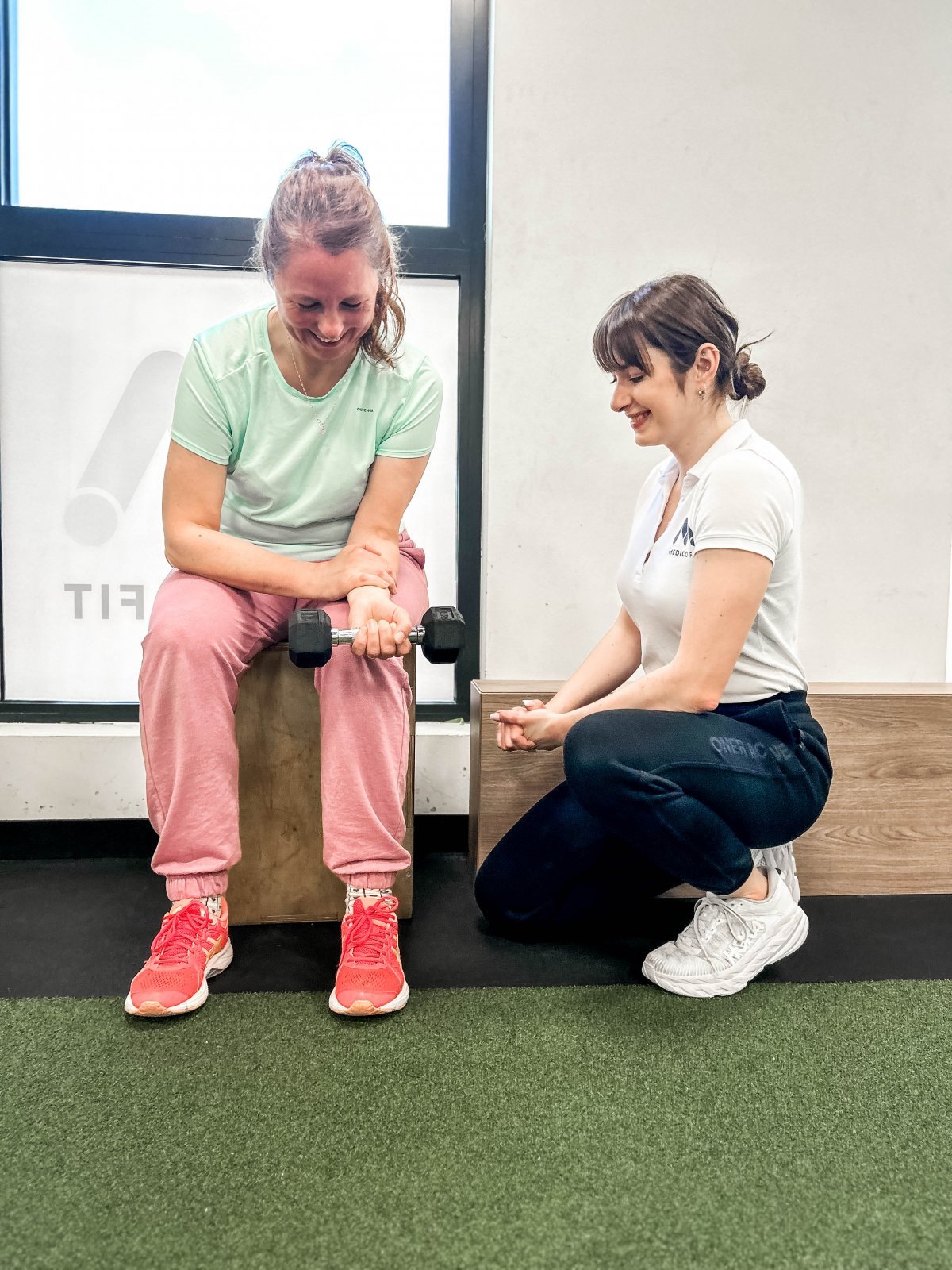
Post-kinesiology programme
At MEDICOFIT clinic, we have prepared a special post-kinesiology programme intended for patients who have completed physiotherapy treatment for cervical spine.
The post-kinesiology program is prepared by kinesiology experts, and it successfully prevents the recurrence of old pain and any potential new ones. It actively prepares you for the everyday and unpredictable stresses placed on your cervical spine and entire body.
Because we believe in a comprehensive treatment at MEDICOFIT clinic, we guide you from cervical spine injury and pain to free movement without pain and restore full strength and mobility to your neck.
WHY CHOOSE SPECIALIST PHYSIOTHERAPY TREATMENT?
- We ensure high treatment success and long-term results.
- Up to 90% lower risk of cervical spine surgery!
- We offer state-of-the-art non-invasive treatment methods that provide optimal conditions for complete recovery and return to activities.
Comprehensive treatment at MEDICOFIT clinic is recommended by numerous renowned orthopaedic surgery specialists.
YOUR PATH TO A NEW LIFE.








